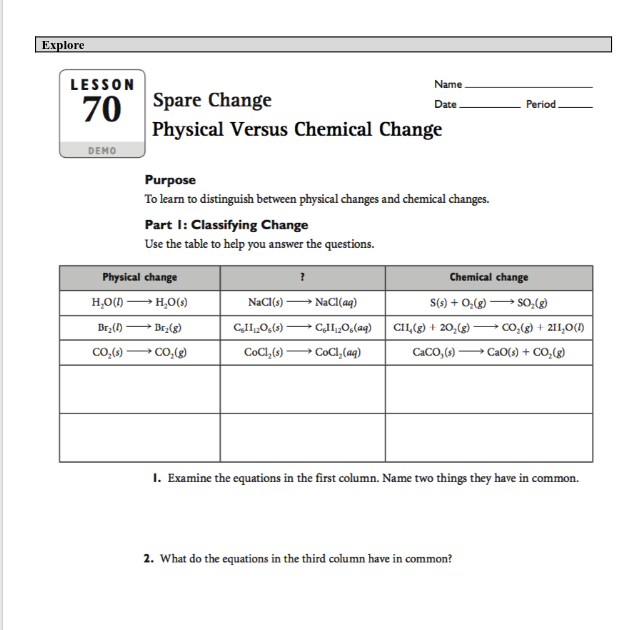|Explore LESSON Name 70 Spare Change Date. Period Physical Versus Chemical Change DEMO Purpose To learn to distinguish between physical changes and chemical changes. Part I: Classifying Change Use the table to help you answer the questions. Physical change Chemical change H,O() → H,O() NaCl(s) → NaCI(aq) S(s) + O;(g) → SO,(®) Br,() Br,(g) GII,0,(9) C,II,0,(aq) ► C©C1,(aq) CII,(8) + 20,(g) → CO,(g) + 211,0(1) CaCO,(s)* Co,(6) →CO,() CoCl,()- CaO(s) + CO,(®) I. Examine the equations in the first column. Name two things they have in common.
|Explore LESSON Name 70 Spare Change Date. Period Physical Versus Chemical Change DEMO Purpose To learn to distinguish between physical changes and chemical changes. Part I: Classifying Change Use the table to help you answer the questions. Physical change Chemical change H,O() → H,O() NaCl(s) → NaCI(aq) S(s) + O;(g) → SO,(®) Br,() Br,(g) GII,0,(9) C,II,0,(aq) ► C©C1,(aq) CII,(8) + 20,(g) → CO,(g) + 211,0(1) CaCO,(s)* Co,(6) →CO,() CoCl,()- CaO(s) + CO,(®) I. Examine the equations in the first column. Name two things they have in common.
Introductory Chemistry: An Active Learning Approach
6th Edition
ISBN:9781305079250
Author:Mark S. Cracolice, Ed Peters
Publisher:Mark S. Cracolice, Ed Peters
Chapter2: Matter And Energy
Section: Chapter Questions
Problem 83E: Particles in the illustration below undergo a chemical change. Which among the remaining boxes, a...
Related questions
Question
100%
Examine the equations in the first column. Name two things the have in common.

Transcribed Image Text:Explore
LESSON
Name
70 Spare Change
Date
Period
Physical Versus Chemical Change
DEMO
Purpose
To learn to distinguish between physical changes and chemical changes.
Part I: Classifying Change
Use the table to help you answer the questions.
Physical change
Chemical change
H,O() H,0(9)
NaCl(s)
NaCl(aq)
S(s) + 0,(g)
→ ClI,0,(aq) CII,(g) + 20,(g) -
→ COC1,(aq)
Br;(1)
- Br2(g)
CII„0,(s)
Co,(g) + 211,0(1)
Co,(g)
CoCl,(9)-
CaCO, (s)
CaO(s) + CO,(g)
I. Examine the equations in the first column. Name two things they have in common.
2. What do the equations in the third column have in common?
Expert Solution
This question has been solved!
Explore an expertly crafted, step-by-step solution for a thorough understanding of key concepts.
This is a popular solution!
Trending now
This is a popular solution!
Step by step
Solved in 2 steps with 1 images

Follow-up Questions
Read through expert solutions to related follow-up questions below.
Follow-up Question
what do the equations in the third column have in common
Solution
Knowledge Booster
Learn more about
Need a deep-dive on the concept behind this application? Look no further. Learn more about this topic, chemistry and related others by exploring similar questions and additional content below.Recommended textbooks for you

Introductory Chemistry: An Active Learning Approa…
Chemistry
ISBN:
9781305079250
Author:
Mark S. Cracolice, Ed Peters
Publisher:
Cengage Learning

General Chemistry - Standalone book (MindTap Cour…
Chemistry
ISBN:
9781305580343
Author:
Steven D. Gammon, Ebbing, Darrell Ebbing, Steven D., Darrell; Gammon, Darrell Ebbing; Steven D. Gammon, Darrell D.; Gammon, Ebbing; Steven D. Gammon; Darrell
Publisher:
Cengage Learning

Chemistry: The Molecular Science
Chemistry
ISBN:
9781285199047
Author:
John W. Moore, Conrad L. Stanitski
Publisher:
Cengage Learning

Introductory Chemistry: An Active Learning Approa…
Chemistry
ISBN:
9781305079250
Author:
Mark S. Cracolice, Ed Peters
Publisher:
Cengage Learning

General Chemistry - Standalone book (MindTap Cour…
Chemistry
ISBN:
9781305580343
Author:
Steven D. Gammon, Ebbing, Darrell Ebbing, Steven D., Darrell; Gammon, Darrell Ebbing; Steven D. Gammon, Darrell D.; Gammon, Ebbing; Steven D. Gammon; Darrell
Publisher:
Cengage Learning

Chemistry: The Molecular Science
Chemistry
ISBN:
9781285199047
Author:
John W. Moore, Conrad L. Stanitski
Publisher:
Cengage Learning

World of Chemistry, 3rd edition
Chemistry
ISBN:
9781133109655
Author:
Steven S. Zumdahl, Susan L. Zumdahl, Donald J. DeCoste
Publisher:
Brooks / Cole / Cengage Learning

Introductory Chemistry: A Foundation
Chemistry
ISBN:
9781337399425
Author:
Steven S. Zumdahl, Donald J. DeCoste
Publisher:
Cengage Learning